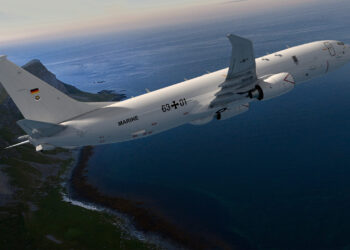US Navy,
USS JOHN C. STENNIS, At Sea: The John C. Stennis Carrier Strike Group (JCSSG) successfully wrapped up Exercise Valiant Shield 2007 while operating in the U.S. 7th Fleet area of responsibility (AOR) Aug. 14.
The eight-day exercise conducted off the coast of Guam, tested the military’s ability to rapidly bring together joint forces in response to any regional contingency. It also enabled the United States to contribute to regional security and stability and demonstrated U.S. commitment in the Pacific.
“The purpose of the exercise was to train in our ability to work in a strike force and joint environment,” said Rear Adm. Kevin M. Quinn, Commander, Carrier Strike Group 3. “We practiced our ability to carry out all of our mission areas in a very dynamic and robust training environment. It’s been great training.”
|
Sailors aboard the nuclear-powered aircraft carrier USS Nimitz (CVN 68) watch as the aircraft carrier USS Kitty Hawk (CV 63) and the nuclear-powered aircraft carriers USS John C. Stennis (CVN 74) transit in formation during a joint photo exercise.
More Military Pictures
|
Valiant Shield, the largest joint exercise in recent history, brought together more than 20,000 Sailors, Marines, Coast Guardsmen and Air Force Airmen to participate in operations consisting of 30 ships and 280 aircraft.
“What we found in Valiant Shield is that we can come together at sea, working in a joint military environment, having not worked with each other a lot before and fall into a strike force construct to conduct integrated combat operations,” said Quinn.
Along with JCSSG, Nimitz and Kitty Hawk Carrier Strike Groups also participated in Valiant Shield. The exercise offered a unique opportunity to have multiple aircraft carriers train together in a maritime environment and enhance operational proficiency.
“What was very striking to me was how well we were able to bring together three separate carrier strike groups and integrate them into a carrier strike force,” said Quinn. “It’s difficult enough to integrate all the elements of a carrier strike group into one cohesive fighting force. It’s another order of magnitude to do that with three strike groups. However, the John C. Stennis Carrier Strike Group performed very well. In fact, all the strike groups in Valiant Shield performed extremely well.”
With the vast area of the Pacific Ocean, integrated sea and air power is essential for immediate response to any contingency.
By bringing these forces together, this training enabled real-world proficiency in detecting, locating, tracking and engaging units at sea, on land and in the air in response to a range of mission areas.
“Valiant Shield showed the flexibility of a carrier strike group,” said Capt. Christopher Murray, deputy commander, Carrier Air Wing (CVW) 9. “When we need to get in close to support ground troops, we can do that, and we’ve done that. This exercise showed another area of expertise; our ability to conduct operations in the open ocean.”
For the “Death Rattlers” of Strike Fighter Squadron (VMFA) 323, a Marine squadron assigned to CVW-9, Valiant Shield provided a valuable learning experience.
“This exercise was vastly different than the combat operations we conducted in the 5th Fleet area of operations,” said Maj. James Erwin, VMFA-323 pilot and operations officer. “It was very much a shift in focus compared to when were providing close-air support for ground troops. In Valiant Shield, we practiced attacking and defending ships. For a Marine squadron, our typical focus is supporting ground forces. However, being integrated into a carrier air wing, we are expected to expand our skill sets to cover all the operations carrier air wings will participate in, and overall, we did well.”
This is the second year the U.S. military has conducted Valiant Shield; the first was held June 2006.
JCSSG includes the Nimitz-class aircraft carrier USS John C. Stennis (CVN 74), embarked CVW-9, Destroyer Squadron (DESRON) 21, the guided-missile cruiser USS Antietam (CG 54), the guided-missile destroyers USS O’Kane (DDG 77), USS Preble (DDG 88) and USS Paul Hamilton (DDG 60) and the fast combat support ship USNS Bridge (T-AOE 10). More than 6,500 Sailors and Marines are assigned to JCSSG.
The squadrons of CVW-9 include: the “Black Knights” of Strike Fighter Squadron (VFA) 154, “Blue Diamonds” of VFA-146, “Argonauts” of VFA-147, Death Rattlers of VMFA-323, “Yellow Jackets” of Electronic Attack Squadron (VAQ) 138, “Golden Hawks” of Carrier Airborne Early Warning Squadron (VAW) 112, “Top Cats” of Sea Control Squadron (VS) 31, “Eightballers” of Helicopter Anti-Submarine Squadron (HS) 8 and “Providers” of Fleet Logistics Support Squadron (VRC) 30.
Stennis, JCSSG’s flagship, left her homeport of Bremerton, Wash., Jan. 16 for a regularly-scheduled deployment and has conducted operations in the U.S. 5th Fleet and U.S. 7th Fleet AOR.
“My strike group has performed magnificently, and I couldn’t be more proud of them,” said Quinn. “Contributing to security and stability in the Middle East, as well as the Pacific, is one of the most important missions of the United States Navy.”
With the conclusion of Valiant Shield, Stennis and its strike group will sail to the U.S. 3rd Fleet AOR, where they will finish the remainder of their 2007 deployment.
“When I look back on this great adventure of ours, the thing I’m most proud of is the performance of our young Sailors and Marines,” said Quinn. “They’ve left the comforts of their homes; they’ve left their families; they’ve gone forward into the combat zone to fight for our country, and their performance in that combat zone has been outstanding.”










